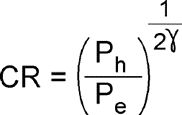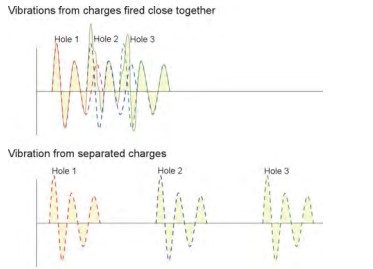Design and Analysis Spreadsheets
Design and Analysis Spreadsheets...
Click on the appropriate tab to access one of our online calculators
Presplit Design Parameters
Introduction
The basis for presplit design is to balance the force applied by the blasthole pressure normal to the presplit line with the force required to overcome the tensile strength of the rock mass. The design strategy to achieve this is:
- Design the charge such that the blast hole pressure Pb is equal to, but not in excess, of the compressive strength of the rock.
- Design the blast hole spacing such that the force applied by the explosives pressure acting on the blast-hole walls is equal to the tensile strength of the rock mass. This should cause a tensile failure in the rock.
To design a charge that delivers a blast hole pressure equal to the compressive strength we use the formula:
Ph = Pe (CR)2γ
This can be re-arranged to give the coupling ratio, CR.

Where
Ph = Blast hole pressure set to the compressive strength of the rock
Pe = Explosion Pressure = 0.125 x density x VOD2
γ = Expansion co-efficient = 1.25
Hole Spacing

The principal behind pre-split spacing is to overcome the tensile strength of the rock (UTS) between the holes using the force applied (Fpressure) to the blast holes by the explosives pressure Pb.
Pressure Applied = UCS x D
Pressure Required = UTS x (S-D)
This is resolved to:
(UCS / UTS ) x D + D = S
Where UCS / UTS = 11
11 x D + D = S
S = 12 x D
The Calculator
Ground Vibration Calculators – PPV and MIC
Introduction
Ground Vibration from Blasting is the radiation of mechanical energy within the rock mass. It comprises various vibration phases travelling at different velocities. These phases may be attenuated, reflected, refracted or scattered so that the resultant vibration at a point will have a complex character. The magnitude of the ground vibration (often referred to as the Peak Particle Velocity in mm/s) as well as frequency is often used to define damage criteria.
Prediction of ground vibrations may be required where blasting in tightly controlled environments, and prediction provides the blast designer with limits on Maximum Instantaneous Charge (MIC) in kg. This is a measure of explosives which may be fired at the same time to avoid positive reinforcement of blast vibrations. Historically and commonly a delay of 8ms between charges is considered enough to effectively separate the resultant vibrations.

The Scaled Distance rule is often used to show the relationship between ground Vibration – PPV, the MIC, and distance from a blast for prediction purposes.

Where:-
PPV = Peak Particle Velocity – mm/s
K = Ground Transmission Constant
D = Distance from Blast (m)
Q = MIC (kg)
a = geological constant
a and K are constants are normally found from analysis of previous blast vibration data using a technique known as regression analysis.
If a and K are known, we can predict the PPV at a point at Distance D, when using a known MIC (Q)
Similarly, if we are constrained to a particular PPV at a point, the Scaled Distance rule will provide the maximum allowable MIC we can safely charge in the blast design:-

Often – if a and K are not known, values of 1143, and -1.6 are used respectively as a first estimation.




